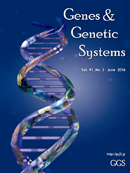Volume 92, Issue 3
Displaying 1-9 of 9 articles from this issue
- |<
- <
- 1
- >
- >|
GGS
-
2017Volume 92Issue 3 Pages Cover-
Published: 2017
Released on J-STAGE: January 20, 2018
Download PDF (684K) -
2017Volume 92Issue 3 Pages Toc-
Published: 2017
Released on J-STAGE: January 20, 2018
Download PDF (20K) -
2017Volume 92Issue 3 Pages Index-
Published: 2017
Released on J-STAGE: January 20, 2018
Download PDF (399K)
Special reviews
-
Article type: Full paper
2017Volume 92Issue 3 Pages 105
Published: June 01, 2017
Released on J-STAGE: January 20, 2018
Download PDF (413K) Full view HTML -
Article type: Full paper
2017Volume 92Issue 3 Pages 107-118
Published: June 01, 2017
Released on J-STAGE: January 20, 2018
Advance online publication: October 06, 2017Download PDF (967K) Full view HTML -
Article type: Full paper
2017Volume 92Issue 3 Pages 119-125
Published: June 01, 2017
Released on J-STAGE: January 20, 2018
Advance online publication: June 30, 2017Download PDF (965K) Full view HTML -
Article type: Full paper
2017Volume 92Issue 3 Pages 127-133
Published: June 01, 2017
Released on J-STAGE: January 20, 2018
Advance online publication: August 09, 2017Download PDF (747K) Full view HTML -
Article type: Full paper
2017Volume 92Issue 3 Pages 135-152
Published: June 01, 2017
Released on J-STAGE: January 20, 2018
Advance online publication: November 22, 2017Download PDF (578K) Full view HTML
Full papers
-
Article type: Full paper
2017Volume 92Issue 3 Pages 153-161
Published: June 01, 2017
Released on J-STAGE: January 20, 2018
Advance online publication: June 30, 2017Download PDF (629K) Full view HTML
- |<
- <
- 1
- >
- >|
